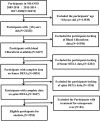Chloroform associated with bone mineral density and bone mineral content in adults: A population-based cross-sectional research
- PMID: 38427675
- PMCID: PMC10906833
- DOI: 10.1371/journal.pone.0290132
Chloroform associated with bone mineral density and bone mineral content in adults: A population-based cross-sectional research
Abstract
Background: Bone mineral density is an important indicator of osteoporosis, and its variation with volatile organic compounds exposure has rarely been studied. However, the relationship between chloroform (an essential volatile organic compounds component) and bone mineral density remains unclear. Consequently, we aimed to explore the relationship between chloroform alone and bone mineral density or bone mineral content.
Methods: Herein, 2,553 individuals aged 18 and above from the National Health and Nutrition Examination Surveys (NHANES) in 2009-2010, 2013-2014, and 2017-2020, were included. We employed two independent t-tests and multi-linear regression models to statistically assess the relationship between chloroform exposure and BMD/BMC in the spine and femoral area.
Results: A "V"-shaped correlation between chloroform exposure and bone mineral density or bone mineral content (BMD/BMC) was observed in the unadjusted model, particularly in the Ward's triangle and femoral neck as a whole. A negative correlation was specifically observed for the Ward's triangle BMD/BMC and L4 BMD/BMC. On the other hand, in the adjusted model, a dominantly negative correlation between the L4 BMC and chloroform exposure was observed over a range of exposure levels. The subgroup analysis revealed a negative correlation between chloroform concentrations and BMC in the femur and spine, especially in women and the 65-80 age population.
Conclusion: Our study revealed a "V" shaped correlation between chloroform and BMD/BMC of the femur and spine in U.S. adults. This finding highlights the fact that prolonged exposure to chloroform may cause the changes in BMD/BMC.
Copyright: © 2024 Li et al. This is an open access article distributed under the terms of the Creative Commons Attribution License, which permits unrestricted use, distribution, and reproduction in any medium, provided the original author and source are credited.
Conflict of interest statement
The authors have declared that no competing interests exist.
Figures



Similar articles
-
Association between Ward's triangle bone mineral density levels and abdominal aortic calcification: Data from the national health and nutrition examination survey 2013-2014.Clin Nutr ESPEN. 2024 Dec;64:344-357. doi: 10.1016/j.clnesp.2024.10.154. Epub 2024 Oct 24. Clin Nutr ESPEN. 2024. PMID: 39461592
-
Prediction of bone mineral density of lumbar spine, hip, femoral neck and Ward's triangle by forearm bone mineral density.J Med Assoc Thai. 2001 Mar;84(3):390-6. J Med Assoc Thai. 2001. PMID: 11460941
-
Relationship between blood manganese and bone mineral density and bone mineral content in adults: A population-based cross-sectional study.PLoS One. 2022 Oct 21;17(10):e0276551. doi: 10.1371/journal.pone.0276551. eCollection 2022. PLoS One. 2022. PMID: 36269752 Free PMC article.
-
Associations between objectively-measured sedentary behaviour and physical activity with bone mineral density in adults and older adults, the NHANES study.Bone. 2014 Jul;64:254-62. doi: 10.1016/j.bone.2014.04.009. Epub 2014 Apr 13. Bone. 2014. PMID: 24735973
-
Use of selective serotonin reuptake inhibitors and bone mass in adolescents: An NHANES study.Bone. 2015 Sep;78:28-33. doi: 10.1016/j.bone.2015.04.042. Epub 2015 May 2. Bone. 2015. PMID: 25940460
References
-
- Bouxsein ML, Eastell R, Lui LY, Wu LA, de Papp AE, Grauer A, et al.. Change in Bone Density and Reduction in Fracture Risk: A Meta-Regression of Published Trials. Journal of bone and mineral research: the official journal of the American Society for Bone and Mineral Research. 2019;34(4):632–42. doi: 10.1002/jbmr.3641 - DOI - PubMed
MeSH terms
Substances
LinkOut - more resources
Full Text Sources
Medical

